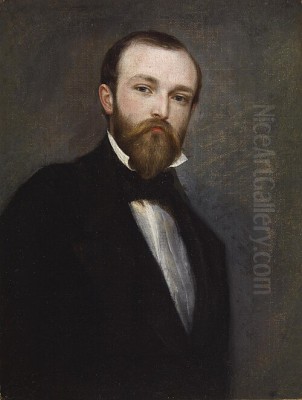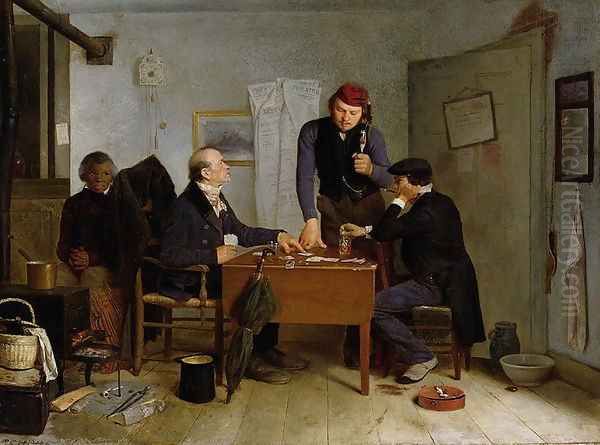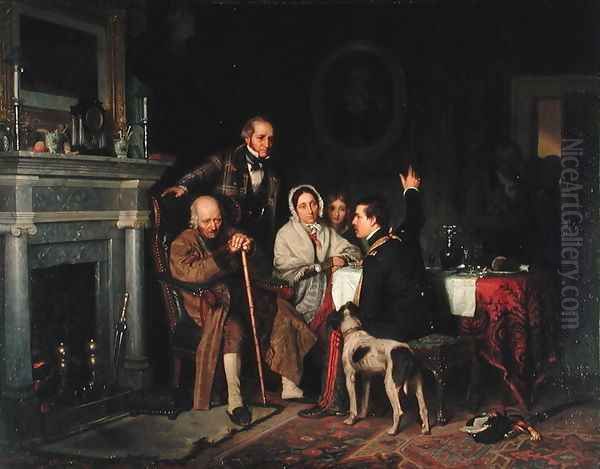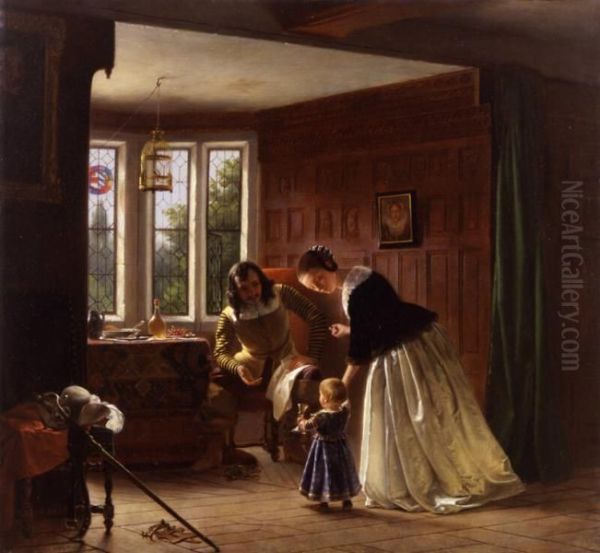
Richard Caton Woodville Sr. stands as a significant, albeit short-lived, figure in nineteenth-century American art. Active primarily during the 1840s and early 1850s, he specialized in genre painting, capturing scenes of everyday American life with meticulous detail and subtle narrative depth. Despite a tragically brief career, his work gained considerable popularity through widely distributed prints, offering a valuable window into the social fabric, customs, and underlying tensions of the United States in the years leading up to the Civil War. His precise style, influenced by European training, combined with distinctly American subject matter, secured his place in the annals of art history.
Early Life and Artistic Inclination
Richard Caton Woodville was born into a prominent and affluent family in Baltimore, Maryland, on April 30, 1825. His background afforded him opportunities for education and cultural exposure. Initially, his path seemed directed towards a different profession; he enrolled at the University of Maryland Medical School and studied medicine for approximately one year. However, the allure of the arts proved stronger than the call of medicine.
Finding his true passion lay in painting, Woodville made the pivotal decision to abandon his medical studies and dedicate himself fully to becoming an artist. This change in direction marked the beginning of a focused, though ultimately brief, artistic journey. His early interest likely involved sketching and observing the life around him in Baltimore, laying the groundwork for the detailed genre scenes that would later define his career. The support or reaction of his wealthy family to this career change is not detailed in common records, but his ability to pursue formal training abroad suggests at least some level of financial independence or backing.
European Training and the Düsseldorf Influence
Seeking formal artistic training unavailable to the same degree in the United States at the time, Woodville traveled to Europe in 1845. He settled in Düsseldorf, Germany, a major center for academic art education that attracted aspiring artists from across Europe and America. There, he enrolled in the Düsseldorf Academy and studied privately under Karl Ferdinand Sohn, a respected painter known for his historical subjects and portraits, and associated with the influential Düsseldorf school of painting.

The Düsseldorf school emphasized precise draftsmanship, detailed realism, smooth finish, and often, narrative or anecdotal subject matter. This environment profoundly shaped Woodville's style. He absorbed the techniques of meticulous rendering, careful composition, and attention to texture and detail that characterized the school. His time in Düsseldorf was crucial for honing his technical skills and developing the polished, highly finished style evident in his mature works.
During his time in Germany, Woodville was part of a vibrant community of American artists studying abroad. He interacted with fellow painters such as Emanuel Leutze, famous for Washington Crossing the Delaware (which was painted in Düsseldorf), Worthington Whittredge, later a prominent Hudson River School painter, John Whetton Ehninger, and Eastman Johnson, who would also become a leading American genre painter. This exchange among expatriate artists undoubtedly provided mutual support and intellectual stimulation, fostering a shared experience of absorbing European traditions while often still focusing on American themes.
Woodville's European experience also exposed him to the rich tradition of Dutch and Flemish genre painting from the 17th century. Masters like Jan Steen and David Teniers the Younger, known for their lively depictions of domestic interiors, taverns, and everyday activities, likely served as important models. Woodville adapted their focus on intimate settings and narrative detail to his own observations of American life, creating a unique blend of European technique and New World subject matter.
Artistic Style: Detail, Narrative, and Realism
Richard Caton Woodville's artistic style is characterized by its meticulous attention to detail, strong narrative element, and commitment to realism, particularly in the depiction of interior spaces. Influenced by his Düsseldorf training and an affinity for earlier Northern European genre painting, he developed a distinctive approach to capturing mid-19th century American life.
His paintings are typically small in scale but densely packed with information. Every object, texture, and facial expression is rendered with careful precision. This detailed realism extends to clothing, furniture, architectural elements, and incidental objects like newspapers, posters, or playing cards, which often contribute to the painting's narrative or theme. He demonstrated a keen ability to depict different materials convincingly, from rough-hewn wood to polished metal or patterned fabrics.

Woodville was a master of composition, often arranging figures in complex but clear spatial relationships within carefully constructed interiors. He frequently used doorways, windows, and furniture to frame scenes or create a sense of depth. His use of light is often sophisticated, employing chiaroscuro (contrasts of light and shadow) to highlight focal points, model forms, and enhance the mood of the scene, recalling the techniques of Dutch masters.
Color in Woodville's work is typically rich and carefully modulated, contributing to the overall realism and atmosphere. Technical analysis has shown his use of traditional mineral pigments alongside newer European pigments available at the time, such as Prussian blue and cobalt blue, indicating his awareness of and access to contemporary materials. His brushwork is generally smooth and controlled, leaving little visible texture, which aligns with the academic finish favored by the Düsseldorf school.
Beyond the technical skill, Woodville's paintings often contain subtle narratives or ambiguous situations, inviting viewers to interpret the interactions and emotions of the figures. While depicting everyday scenes, his work frequently touches upon broader social or political themes relevant to antebellum America, such as politics, generational differences, the impact of news, and social customs, though often presented with a degree of humor or gentle satire rather than overt critique.
Major Works: Capturing American Moments
Despite his short career, Woodville produced several paintings that became highly regarded and widely known, primarily through engravings. These works exemplify his style and thematic concerns.
Scene in a Bar-Room (1845): This early significant work, likely based on observations in his native Baltimore, depicts two men warming themselves by a hearth in a tavern setting. It showcases his burgeoning skill in rendering interiors, textures (like the rough brickwork and wooden beams), and character types. The scene captures a typical aspect of male social life in the period and establishes his interest in enclosed, intimate genre settings.
The Card Players (1846): This painting presents a more complex interior scene, featuring several figures engrossed in a game of cards, likely in a tavern or back room. Woodville masterfully handles the grouping of figures, the play of light across the scene, and the varied expressions and postures, suggesting underlying tensions or narratives within the game. The intricate detail in the setting and costumes further enhances the sense of realism and captured moment. This work was selected for engraving by the American Art-Union, significantly boosting its visibility.

War News from Mexico (1848): Perhaps Woodville's most famous painting, this work depicts a group of American men gathered on the porch of a building labeled "American Hotel," reacting to news from the Mexican-American War (1846-1848) being read aloud from a newspaper. The figures represent a cross-section of society, displaying a range of emotions from intense interest to skepticism. The painting is notable not only for its commentary on the war's impact on the home front but also for its subtle depiction of communication technology (the newspaper, possibly informed by the telegraph) and the formation of public opinion. Its popularity was immense, largely due to the widely distributed Art Union engraving.
Politics in an Oyster House (1848): Another keenly observed interior scene, this painting shows two men engaged in what appears to be a heated political discussion in the private booth of an oyster cellar, a common urban eatery. The contrast between the younger, earnest speaker and the older, more skeptical listener creates a dynamic narrative. The detailed setting, including the oyster shells and tableware, grounds the scene in everyday reality while hinting at the passionate political debates of the era.
Old '76 and Young '48 (1849): This work directly addresses generational differences and attitudes towards patriotism and war. It portrays an elderly veteran of the American Revolution (representing "'76") reacting with dismay or disapproval as a younger man (representing "'48," the time of the Mexican-American War) reads enthusiastically from a newspaper, likely recounting recent military victories. A third figure, possibly the younger man's father, looks on thoughtfully. The painting contrasts the ideals of the founding generation with the expansionist fervor of the contemporary era, capturing a complex moment in American identity.
These representative works highlight Woodville's talent for combining technical polish with insightful observation of American character and society during a period of significant change and tension.
Dissemination Through Prints: The American Art-Union
A crucial factor in Richard Caton Woodville's contemporary fame and lasting influence was the American Art-Union. Active primarily from 1839 to 1852, this New York-based organization aimed to promote American art and cultivate public taste. It operated on a subscription model: members paid an annual fee, receiving an engraving of a commissioned or purchased American painting, and entered a lottery to win original artworks acquired by the Union.
The Art Union purchased several of Woodville's paintings, including The Card Players and War News from Mexico. These works were then engraved in high-quality prints by skilled artisans like Alfred Jones and distributed to thousands of the Union's members across the country. This system bypassed traditional gallery structures and brought contemporary American art directly into middle-class homes.
For Woodville, the Art Union's patronage was transformative. It meant his detailed, narrative scenes reached a far wider audience than would have been possible through exhibitions alone. The engravings of War News from Mexico, in particular, became one of the most recognizable American images of the mid-19th century. This widespread dissemination cemented Woodville's reputation and ensured his work became part of the national visual culture.
The Art Union's selection of Woodville's work also placed him alongside other prominent American artists whose paintings were distributed in engraved form, such as George Caleb Bingham, known for his scenes of Western life and politics, and William Sidney Mount, another key figure in American genre painting. The comparison with artists like William Ranney, whose work was also featured by the Art Union, further situated Woodville within the mainstream of popular American art of the period. Although the Art Union was eventually dissolved due to legal challenges regarding its lottery system, its impact on popularizing artists like Woodville was undeniable and long-lasting. His images, familiar through these prints, continued to resonate and were later included in historical publications and textbooks.
Personal Life and Untimely Death
Details about Richard Caton Woodville's personal life remain somewhat fragmented, occasionally overshadowed by confusion with his son of the same name. Sources indicate he married twice during his relatively short life. One of these marriages reportedly ended contentiously, involving a divorce proceeding in London. Some accounts, possibly conflating him with his son or based on less substantiated information, have even suggested complexities like bigamy, hinting at a potentially tumultuous private life running parallel to his meticulous artistic endeavors.
His promising career was cut tragically short. While living and working abroad, primarily between Düsseldorf, Paris, and London after his initial training, Woodville died in London on August 13, 1855. He was only 30 years old. The cause of death was recorded as an overdose of morphine. At the time, morphine was available relatively easily and used for various medical and non-medical reasons, including pain relief and potentially as a form of self-medication or recreational use. Whether the overdose was accidental or intentional remains unclear from definitive historical records pertaining specifically to him, though the circumstances surrounding his son's later death sometimes cause confusion. His early demise silenced a unique voice in American art just as his reputation was solidifying.
The Son: Richard Caton Woodville Jr.
It is essential to distinguish Richard Caton Woodville Sr. (1825-1855), the American genre painter, from his son, Richard Caton Woodville Jr. (1856-1927). Born in London the year after his father's death, the younger Woodville also became a successful artist, but his career path and subject matter differed significantly.
Richard Caton Woodville Jr. became a prominent British painter, illustrator, and war correspondent, particularly renowned for his dramatic and detailed battle scenes. He studied painting in Düsseldorf, like his father, but also in Paris. He gained fame covering conflicts for the Illustrated London News, including the Russo-Turkish War (1877-78) and the Anglo-Egyptian War (1882). His vivid depictions of battles like Tel-el-Kebir and Kassassin were highly popular.
Collaborations mentioned in some sources, such as working with the French military painter Alphonse-Marie-Adolphe de Neuville on illustrations, or potentially with British battle painter Ernest Crofts (known for historical military scenes like the Napoleonic Wars or English Civil War), almost certainly refer to the son, Richard Caton Woodville Jr., whose career aligned with military art and illustration in the later 19th and early 20th centuries.
The younger Woodville's death also contributes to potential confusion. Richard Caton Woodville Jr. died in 1927, reportedly from suicide following struggles possibly related to his finances or changing tastes in art. The circumstances of his death – sometimes incorrectly attributed to his father – involved an overdose and a verdict of suicide, adding another layer of tragedy to the family name but distinct from the father's earlier passing in 1855. Recognizing the separate identities and careers of father and son is crucial for accurate art historical understanding.
Art Historical Legacy and Evaluation
Richard Caton Woodville Sr. holds a secure place in American art history as a leading genre painter of the antebellum period. Despite producing fewer than twenty known paintings due to his short life, his work is highly valued for its technical skill, narrative richness, and insightful portrayal of American society.
He is praised for successfully adapting the meticulous techniques of the Düsseldorf school and the traditions of Dutch genre painting to American subjects. His ability to render detailed interiors, capture nuanced human interactions, and subtly comment on contemporary issues distinguishes his work. Paintings like War News from Mexico are considered iconic images of the era, reflecting national concerns and the growing importance of mass communication.
His legacy was significantly shaped by the American Art-Union's distribution of engravings after his paintings. This made his work accessible and familiar to a broad public, ensuring his influence extended far beyond elite art circles. His paintings continue to be studied for their artistic merit and as historical documents offering insights into the social customs, political climate, and everyday life of the United States in the 1840s and 1850s.
Woodville's work is represented in major American museum collections, including the Walters Art Museum in his native Baltimore, which holds several key pieces and has organized exhibitions dedicated to his art. While some interpretations might debate the extent or nature of the social commentary in his work – whether it reinforces or subtly critiques contemporary norms and political stances – his skill as an observer and painter is widely acknowledged.
Compared to contemporaries like George Caleb Bingham or William Sidney Mount, Woodville offers a perspective often focused on more intimate, interior scenes, frequently set in urban or tavern environments rather than the frontier or rural settings favored by others. His European training perhaps lent his work a different kind of polish and compositional complexity. Ultimately, Richard Caton Woodville Sr. is remembered as a gifted artist whose keen eye and skilled hand captured the character and complexities of his time, leaving behind a small but significant body of work that continues to engage viewers.
Conclusion
Richard Caton Woodville Sr.'s life was one of artistic dedication compressed into a tragically short span. From his decision to forsake medicine for art to his rigorous training in Düsseldorf and his subsequent focus on depicting the nuances of American life, he forged a distinct path. His paintings, characterized by meticulous detail, complex compositions, and subtle narratives, offer invaluable glimpses into the social and cultural landscape of the United States before the Civil War. Popularized through engravings, his work reached a wide audience, securing his contemporary fame and lasting historical importance. Though his output was limited, the quality and insight of his art confirm his status as a significant figure in the development of American genre painting, a chronicler whose detailed scenes continue to tell stories of a nation on the cusp of profound change.